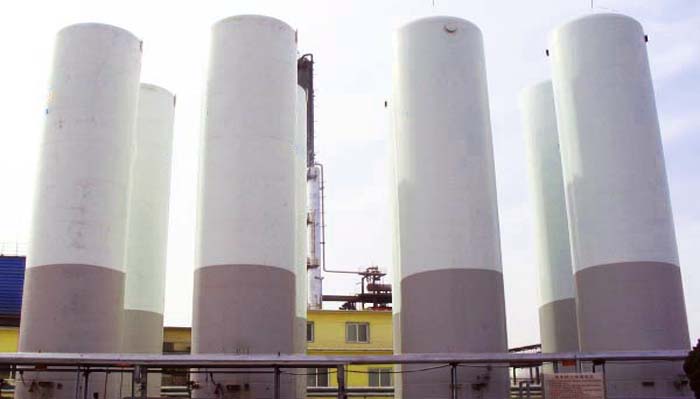Product Category
lng cryogenic storage tank classification
Date: Feb 20, 2020

The LNG cryogenic storage tank is obtained by purifying natural gas, compressing and heating it, and removing N2, CO2, H2O, sulfide, solid impurities, etc. under the action of mixed refrigerant, and finally obtain LNG in the liquid form of -162 ° C. After the above liquefaction process, the volume of natural gas has been reduced by 600 times. LNG is usually stored in a cryogenic storage tank at -162 ° C and a pressure of about 0.1 MPa.
(1) Classification of LNG storage tanks by capacity
①Small-sized storage tank: The capacity is 5 ~ 50m³. It is often used in civil LNG vehicle filling points and civil gas liquefaction stations.
② Medium-sized storage tanks: 50 ~ 100m³, mostly used in industrial gas liquefaction stations.
③Large storage tank: The capacity is 100 ~ 1000m³, suitable for small LNG production facilities.
④Large storage tank: capacity of 10,000 to 40,000 m³, used for basic load type and peak regulation type liquefaction device.
⑤ Extra large storage tank: The capacity is 4 ~ 200,000 m³, and it is used for LNG receiving station.
In 1995, the storage tank capacity exceeded 200,000 m³, and it developed towards a larger storage tank capacity.
(2) Classification of LNG storage tanks by shape
① Spherical tank: Generally used for small and medium capacity storage tanks (but some large storage tanks also use spherical tanks).
② Cylindrical tank: used in storage tanks of various capacities.
(3) LNG cryogenic storage tanks can be further divided into two types: above ground type and underground type (a. Semi-underground type; b. Full underground type; c. Underground pit type) according to the place where they are placed. (4) Classification of LNG storage tanks according to their construction materials
(4) Classification of LNG storage tanks according to their construction materials
①Bimetal type: The inner tank and outer shell are made of metal materials. The inner tank is made of cryogenic resistant stainless steel or aluminum alloy, and the outer casing is made of steel for pressure vessels.
② Film type: The inner cylinder of this type of storage tank is made of 36Ni steel with a thickness of 0.8 ~ 1.2mm.
③ Prestressed concrete type: The inner cylinder of this type of storage tank is constructed with cryogenic resistant metal materials, and the outer casing is constructed with prestressed concrete.
(5) LNG cryogenic storage tank structure
①Vertical storage tank: a small vertical LNG storage tank of 100m³ is used as a gas injection device for automobiles.
②Vertical son-mother type storage tank: Usually, three or more daughter tanks are connected in parallel to form an inner tank to meet the requirements for storing large-capacity liquid storage. Its structure is that multiple child tanks (usually 3 to 7) are assembled side by side in a large outer tank (also called a mother tank). The sub-tanks are usually vertical cylindrical, and the volume of each sub-tank is more than 100 ~ 150m³. The outer tank has a cylindrical shape with a vertical flat bottom arch cover, and most of them are large storage tanks with a volume of 300 ~ 1000m³ and a working pressure of 0.2 ~ 1.2MPa.
③ Spherical storage tank: the inner and outer tanks are spherical. Most are 200 ~ 1500m³, and the working pressure is 0.2 ~ 1.0MPa.
④ Typical storage tanks with totally enclosed enclosures: Above-ground storage tanks with a capacity of 80,000 m³, mostly used for LNG receiving terminals (maximum capacity of 200,000 mm³)
(1) Classification of LNG storage tanks by capacity
①Small-sized storage tank: The capacity is 5 ~ 50m³. It is often used in civil LNG vehicle filling points and civil gas liquefaction stations.
② Medium-sized storage tanks: 50 ~ 100m³, mostly used in industrial gas liquefaction stations.
③Large storage tank: The capacity is 100 ~ 1000m³, suitable for small LNG production facilities.
④Large storage tank: capacity of 10,000 to 40,000 m³, used for basic load type and peak regulation type liquefaction device.
⑤ Extra large storage tank: The capacity is 4 ~ 200,000 m³, and it is used for LNG receiving station.
In 1995, the storage tank capacity exceeded 200,000 m³, and it developed towards a larger storage tank capacity.
(2) Classification of LNG storage tanks by shape
① Spherical tank: Generally used for small and medium capacity storage tanks (but some large storage tanks also use spherical tanks).
② Cylindrical tank: used in storage tanks of various capacities.
(3) LNG cryogenic storage tanks can be further divided into two types: above ground type and underground type (a. Semi-underground type; b. Full underground type; c. Underground pit type) according to the place where they are placed.

①Bimetal type: The inner tank and outer shell are made of metal materials. The inner tank is made of cryogenic resistant stainless steel or aluminum alloy, and the outer casing is made of steel for pressure vessels.
② Film type: The inner cylinder of this type of storage tank is made of 36Ni steel with a thickness of 0.8 ~ 1.2mm.
③ Prestressed concrete type: The inner cylinder of this type of storage tank is constructed with cryogenic resistant metal materials, and the outer casing is constructed with prestressed concrete.
(5) LNG cryogenic storage tank structure
①Vertical storage tank: a small vertical LNG storage tank of 100m³ is used as a gas injection device for automobiles.
②Vertical son-mother type storage tank: Usually, three or more daughter tanks are connected in parallel to form an inner tank to meet the requirements for storing large-capacity liquid storage. Its structure is that multiple child tanks (usually 3 to 7) are assembled side by side in a large outer tank (also called a mother tank). The sub-tanks are usually vertical cylindrical, and the volume of each sub-tank is more than 100 ~ 150m³. The outer tank has a cylindrical shape with a vertical flat bottom arch cover, and most of them are large storage tanks with a volume of 300 ~ 1000m³ and a working pressure of 0.2 ~ 1.2MPa.
③ Spherical storage tank: the inner and outer tanks are spherical. Most are 200 ~ 1500m³, and the working pressure is 0.2 ~ 1.0MPa.
④ Typical storage tanks with totally enclosed enclosures: Above-ground storage tanks with a capacity of 80,000 m³, mostly used for LNG receiving terminals (maximum capacity of 200,000 mm³)
Next article:
Send Your Inquiry
We not only provide a good product, but also provide high quality service. If you are interested in our products,
you can contact us in the following ways.
you can contact us in the following ways.







